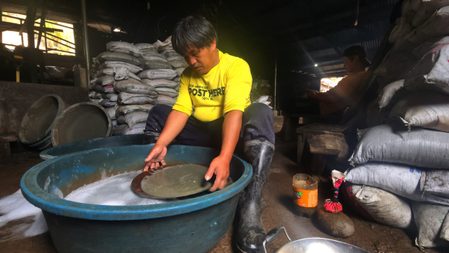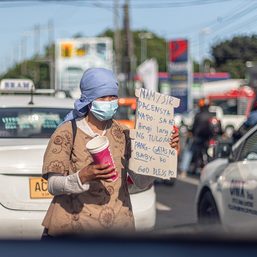SUMMARY
This is AI generated summarization, which may have errors. For context, always refer to the full article.
![[OPINION] Golden Girls: Filipino women’s contributions to artisanal and small-scale gold mining](https://www.rappler.com/tachyon/2023/11/golden-girls-ispeak-nov-7-2023.jpg)
Among the most economically significant yet grossly unrecognized contributions to our local, national, and global economies is the under/unpaid and undervalued labor of women. Though women’s labor is diverse and varies within specific contexts, in many economies it can be characterized by how it is affected by the burden of reproductive work. Reproductive work is work such as child care, cooking, cleaning, and any kind of labor necessary to sustain the household economy and to ensure the welfare of its members in order for them to engage in productive work. Such work is often ascribed to women because of gender norms and standards. In our current economic framework, reproductive work is rarely understood as “real” or valuable work because it is not remunerated. This is in stark contrast to “productive” work, which is often within the purview of male workers. Productive work is generally perceived as “real” work or seen as more valuable because it produces monetary outcomes.
When it comes to their work, they [women] handle both productive and reproductive tasks. They take care of various household chores. And then they go out to work as well, for the sake of their families. Then they come home, again for their families. At the end of the day, even though the men are the ones providing, when they come home, it’s the women who take care of them. But because it’s the men who are providing, it seems like the focus is only on the money they bring in. But if we monetize the efforts of women, it would actually amount to a higher sum.“ – Gloria Langbayan, Gender and Development Focal Person, Municipal Government of Sagada, Mountain Province
As aptly stated by Ms. Langbayan, a profit-oriented economic system that ascribes value to monetary outcomes renders women’s reproductive labor (also called household/domestic work) invisible. This unfortunate reality leads to a lack of recognition and support for women’s work. Though invisible, women’s reproductive work or unpaid care work is far from invaluable and, in fact, provides a huge subsidy to global, national, and local economies. In the context of our global economy, Oxfam estimates that such work can be valued at a minimum of $10.8 trillion a year.
Reproductive work also affects women’s prospects to engage in formal and paid work as they are seen as “risky investments” due to the expectation that their reproductive work will interfere with their careers. Being overburdened by unpaid care work and being unable to meaningfully engage in paid work renders women economically vulnerable, which is considered a form of gender-based violence. Such vulnerability also opens women up to other forms of violence, such as domestic and sexual violence, as their financial dependence on their partners forces them to stay in abusive relationships. Poverty is also among the main factors that push women into prostitution.
Women’s labor in artisanal and small-scale gold mining
In artisanal and small-scale gold mining (ASGM) communities in Sagada, Mountain Province and Paracale, Camarines Norte, women carry the triple burden of productive work, reproductive work, and community management. Much like their reproductive roles, women’s community management roles often go unpaid. Such roles involve ensuring the community’s safety and cleanliness, participating in trainings and activities related to community management organized by the government and development organizations, and organizing religious activities. On the other hand, community management roles usually taken by men are considered leadership roles (barangay captain, councilors, etc.) and are, therefore, remunerated.
Due to the constraints of their reproductive labor as well as the lack of access to proper training and education, women often only have the opportunity to engage in flexible and seasonal work in the ASGM sector. Though their income is considered supplementary to the income of their husbands, it is essential to ensure that they are able to make ends meet every day.
Most small-scale women miners in Sagada and Paracale prefer work in ASGM as it provides them with higher income than agriculture, fishing, and other forms of livelihood.
“Even if [working as a mucker] is difficult, we still work day and night whenever possible because this [work] gives a better source [of income] for our household and our children’s expenses. Though this is not enough because I am sending all nine of my children to school, we no longer have to borrow money for our children’s rent and allowances. When you work here as a mucker, you have to wait for 4-6 months before it [the waste ores] will be processed. But at least you are expecting something that you can use for debt repayment; unlike before, that source of income was tough.” – Hariette Reyla, Brgy. Fidelisan, Sagada, Mountain Province
However, women only have the opportunity to engage in paid labor in the ASGM sector a few months in a year. Since they are usually considered for freelance and auxiliary roles, women are only given work that is available seasonally, such as mucking. For the rest of the year, when no available sacks of ore are available for mucking, women are often found seeking other forms of income by taking on occupations such as farming, working as a laundryperson, weaving (in Sagada), and seeking ways to start their own micro businesses (in Paracale). In all these endeavors, women are hampered by the weight of child care and domestic work.
Though largely unrecognized, women’s economic contributions in the ASGM sector and in their community as a whole are significant. They are heavily involved in gold processing; usually in charge of cleaning, panning, and sluicing. Women in mining sites are also hired as cooks, dishwashers, and cleaners.
In Paracale, women are also in charge of separating gold from the gold amalgam (a mixture of mercury and gold). Such work is detrimental to their health as it places them in direct contact with mercury, a highly toxic substance, which if inhaled or touched can cause severe respiratory, reproductive, and other health problems. It is especially dangerous for pregnant women as mercury can cause brain damage as well as hearing and vision impairment for their unborn child. It can also cause miscarriages. Toxic as the substance may be, it does not deter small-scale gold miners from engaging in this ancient practice of gold amalgamation as it is essential to the survival of their families.
Apart from their work in the mining sites, mining associations in Sagada and Paracale also rely on women to ensure the processing of documents for their formalization and compliance with government requirements. Such work is essential for the association’s recognition and their ability to receive government support. Women sometimes also act as financiers of small-scale mining operations and are the ones who represent their communities in meetings and dialogues with the government and non-government organizations, as the management of their community is a significant concern for women.
Despite the significant contributions of women, mining still prevails as a predominantly male occupation, and women in ASGM are still paid less than their male counterparts. Leadership roles still remain within the purview of male miners. Available statistics show that of the 500,000 workers in the ASGM sector, only 18,000 are women. Inequality in ASGM in the Philippines persists because of the prevailing norm that miners must be men. Such is not the case, as women are very much present in small-scale gold mining and should be given the recognition they deserve.
Moving forward, clear mechanisms must be adopted for government agencies to support women’s work in ASGM through the provision of gender-responsive services and resources to lessen the burden of their reproductive work, increase access to social and public services, and to foster an enabling environment for women to engage in productive work. The issue of women’s labor is a larger economic concern that requires a holistic approach which includes significant changes in the workplace to reflect the realities of women, their reproductive work, and gender-related issues that produce gender inequality. Such an approach involves the formalization of workers in the ASGM sector, access to financial resources and better technologies, and proper knowledge management of the realities on the ground. It also requires the collaboration of government agencies and units, civil society organizations, the academe, and the private sector. – Rappler.com
This piece was written by Meggy Katigbak, the National Gender Specialist of the Artisanal Gold Council for the planetGOLD Philippines project, which is funded by the Global Environment Facility and implemented by the UNE and UNIDO in partnership with DENR-MGB. The gender component of the project seeks to increase the recognition of and support for women’s work in ASGM in Sagada, Mountain Province and Paracale, Camarines Norte. It is also working towards increasing women’s access to work in ASGM to uplift the sector, as it recognizes the significant contribution of women and the economic possibilities of formalizing and supporting their work in ASGM.
Add a comment
How does this make you feel?

![[OPINION] Unpaid care work by women is a public concern](https://www.rappler.com/tachyon/2024/07/20240725-unpaid-care-work-public-concern.jpg?resize=257%2C257&crop_strategy=attention)
![[DECODED] The Philippines and Brazil have a lot in common. Online toxicity is one.](https://www.rappler.com/tachyon/2024/07/misogyny-tech-carousel-revised-decoded-july-2024.jpg?resize=257%2C257&crop_strategy=attention)


![[OPINION] Why women seek divorce](https://www.rappler.com/tachyon/2024/06/TL-women-seeking-divorce-june-14-2024.jpg?resize=257%2C257&crop_strategy=attention)
There are no comments yet. Add your comment to start the conversation.